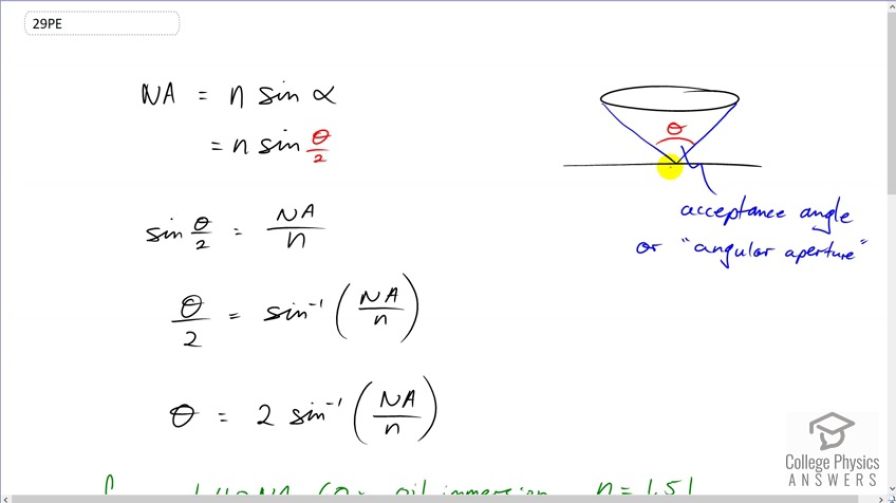Question
You switch from a 1.40NA 60x oil immersion objective to a 0.35NA 20x air immersion objective. What are the acceptance angles for each? Compare and comment on the values. Which would you use first to locate the target area on your specimen?
Final Answer
oil immersion lens:
air immersion lens:
Solution video
OpenStax College Physics, Chapter 26, Problem 29 (Problems & Exercises)

vote with a rating of
votes with an average rating of
.
Calculator Screenshots
Video Transcript
This is College Physics Answers with Shaun Dychko. The objective lens of a microscope has an acceptance angle which is the angle on the tip of this cone of light that goes into the objective. And so, the greater the angle, the greater the resolution because there's more light getting into the objective. Now, we're going to compare a 1.40 numerical aperture 60 times oil immersion lens with a 0.35 numerical aperture 20 times magnification air immersion lens. And so, we need the indexes of refraction for the media through which the light travels, and so it's 1.51 for oil and it's 1.00 for air. And, we're going to figure out the acceptance angle in each case. So, first we'll start with this formula that says the numerical aperture is the index of refraction of the medium through which the light is traveling multiplied by sine of alpha, which is half of the acceptance angle. And so, we'll divide both sides by index of refraction N and we'll get sine of half the acceptance angle is the numerical aperture divided by the index of refraction. And then, we'll take the inverse sine of both sides to get Theta over two is inverse sine of that and then multiply both sides by two. And, we solve for Theta. So, we have a formula now for the acceptance angle. That's two times the inverse sine of the numerical aperture divided by the index of refraction. So, in the case of this first oil immersion objective, we have the acceptance angle is two times the inverse sine of 1.4 divided by 1.51, which is 140 degrees. And then, for the second air immersion lens, we have the acceptance angle is two times the inverse sine of 0.35 numerical aperture divided by the index of refraction of air, which is 1.00 giving an acceptance angle of 41 degrees. So, the air immersion lens sees only a smaller piece of the sample because of this smaller acceptance angle. So, because it sees only a smaller piece, it can more precisely locate the target. And so, this is the lens that should be used first. And then after locating the target properly, the second lens can be switched in order to get a better resolution look at the target.
